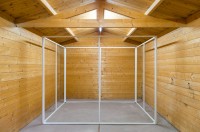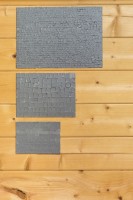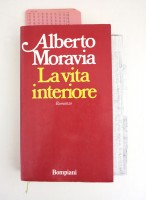Alessandro Bava
VITA INTERIORE
31 Marzo 2018 – 10 Maggio 2018
Vita Interiore e’ la prima mostra personale di Alessandro Bava. Bava presenta nuovi lavori in 2d e 3d intorno ad un’architettura in miniatura, un sancta sanctorum, progettato assimilando protocolli di disegno automatizzato, simili agli algoritmi usati nelle applicazioni basate sulla geolocalizzazione, in un processo di design interamente analogico. Questo lavoro è intitolato “Habitat” ed è inteso come un rettangolo di selezione di un nuovo universo che definisce una capanna primitiva post-umana e uno spazio sacro. I dipinti in mostra sono rendering di modelli e facciate in grigio neutro, il colore dei software CAD utilizzati in architettura. Gli altri lavori presenti nella mostra tratteggiano ipotetiche forme di vita e identità in una simulazione attraverso Golems in miniatura, icone e divinità domestiche.
Excerpt from a text by Federico Campagna
At first glance, prophecy is a self-defeating form of language. It easily lends itself to the fraudulence of soothsayers and fortune-tellers, to the point that today it is most commonly associated with casting predictions about the future. It speaks of imaginary entities as if they existed on the level of factuality, thus allowing the assault of any form of historical or scientific criticism. It claims to be the message of an invisible speaker who is nowhere to be found, thus stimulating the most farcical forms of fundamentalism and cynicism. Yet, prophecy should be understood on a plane which is not that of mere literality. As claimed by Shi’a Islam, a Prophet would be mute without an Imam who is able to interpret his Revelation beneath the level of mere literality. An icon is a holy object, while a royal painting by Velazquez isn’t, because an icon is not a medium but a place where the ineffable dimension of existence makes itself manifest. Likewise, a sacred stone in archaic societies is not substantially unlike any other stone: what marks it as a holy object (Mircea Eliade would say, as a theophany) is the fact that it is a place where the divine makes itself manifest. But what is it, that turns an object or a linguistic medium into an example of prophecy? Is it the work of its creator, or that of its interpreter? Is an icon painter (or even a saint-painter, as Florensky advocated) enough to create an icon, or is it rather the faith of its viewer that is capable of placing the ineffable dimension of existence within it? Certainly, prophecy is a collaborative form of language. The interpreter is at least as important as the prophet, and any attempt at using prophetic language can be rendered futile by the audience’s inability to interpret it. But even when it is not (or no longer) understood, prophetic language remains a passage stretching beyond the limitations of our traditional uses of language. Neither descriptive nor sentimental, neither imperative not entertaining, prophecy acts as a form of language which alone is capable of reminding us of that dimension of existence (including of our very existence) which is beyond the reach of any language.
Prophecy has nothing to do with foretelling the future or conveying the will of ‘the true God’. By definition, the future, as a linguistic construction, exist in the linguistic series of linear time – and as such it cannot be foretold since, if we did, it would no longer be ‘future’. The notion of God, on the other hand, is to be understood accurately. If we think of a Demiurge, a superhuman artisan who created the world like a potter makes a vase, then we can possibly imagine divining Its will. But if we think of a divine principle that is irreducible to any precise comparison with the world that can be described linguistically, then we cannot feasibly conceive the notion of a divine ‘will’. Prophecy as such, has one aim only: to remind its audience that the limits of language fall far shorter than the realm of what there ‘is’. And nothing more. To do so, prophecy proceeds cosmologically, that is, by offering a depiction of the world that implicitly requires a field outside it. The message of prophecy rests beneath different and at time contradictory linguistic contents, since it does not concern the factual ‘world’ as we commonly understand it, but rather the very notion of ‘world’ as that cosmos which can be created through the ordering action of language. Even religious prophecy concerns not only what follows the first instance of God’s speaking, but more importantly the silence that came before God’s first word and that still accompanies God’s ongoing world-making speech. Yet, prophecy cannot speak about this silence. All it can do, is helping its audience to approach it in the same way that we approach a memory: by chasing it while its rushes away from us, ultimately retaining of it only a vague nostalgia coated in fragments of dream.
This central function of prophetic language accounts for its importance even today, in an age that has seemingly overcome any attachment to ancient practices such as prophecy. If we consider our contemporary world, we can’t help noticing how our daily existence has been almost entirely confined within the bounds of what can be grasped by one form of descriptive language or another – may it be the language of science, of finance, of citizenship, of gender, and so on. Whatever refuses or is unable to be reduced to a stockpiling of units of information, is destined to be banished from legitimate existence altogether as a form of superstition – much as it happens to those undocumented migrants whose life has lost access to the linguistic series of citizenship, or to those impoverished classes who desperately struggle to hold onto ethno-nationalist categories just as they slip out of the linguistic series of the economy. As I argued in my previous book Technic and Magic, it is only through a deep re- imagination of our understanding of what constitutes ‘reality’, that we might be able to break out of the cage of this kind of metaphysics and of the field of the ‘possible’ which it goes to create. of a philosophical discourse. Whereof one cannot speak, thereof one can prophesize, in the hope of remembering and of helping others to remember.
Alessandro Bava was born in January 1988, studied architecture at the Architectural Association, is currently based in Europe.



